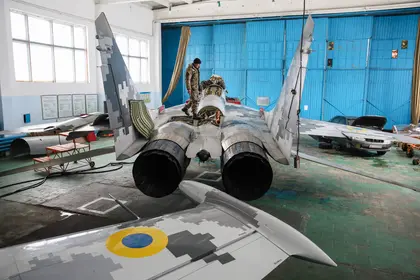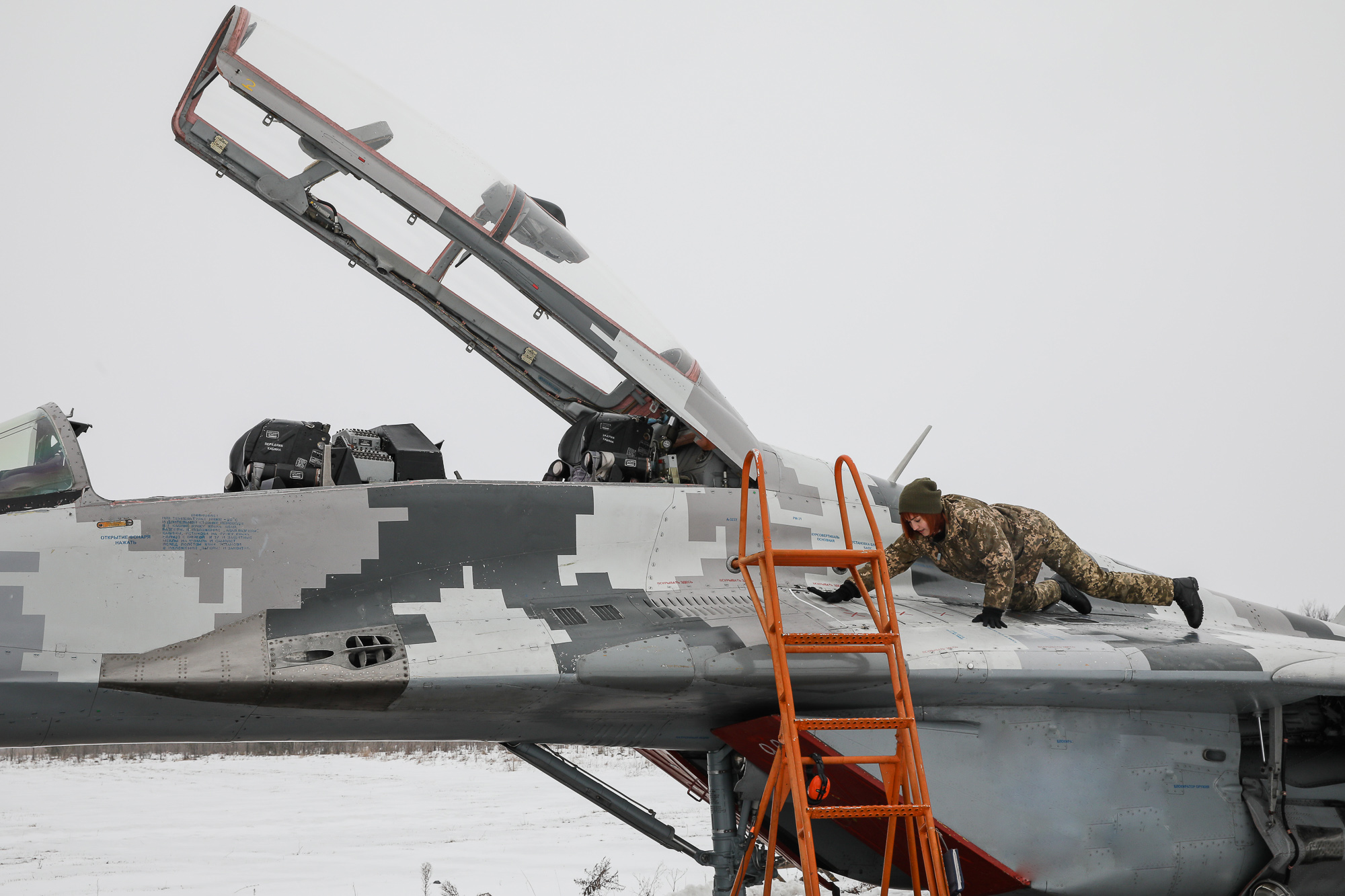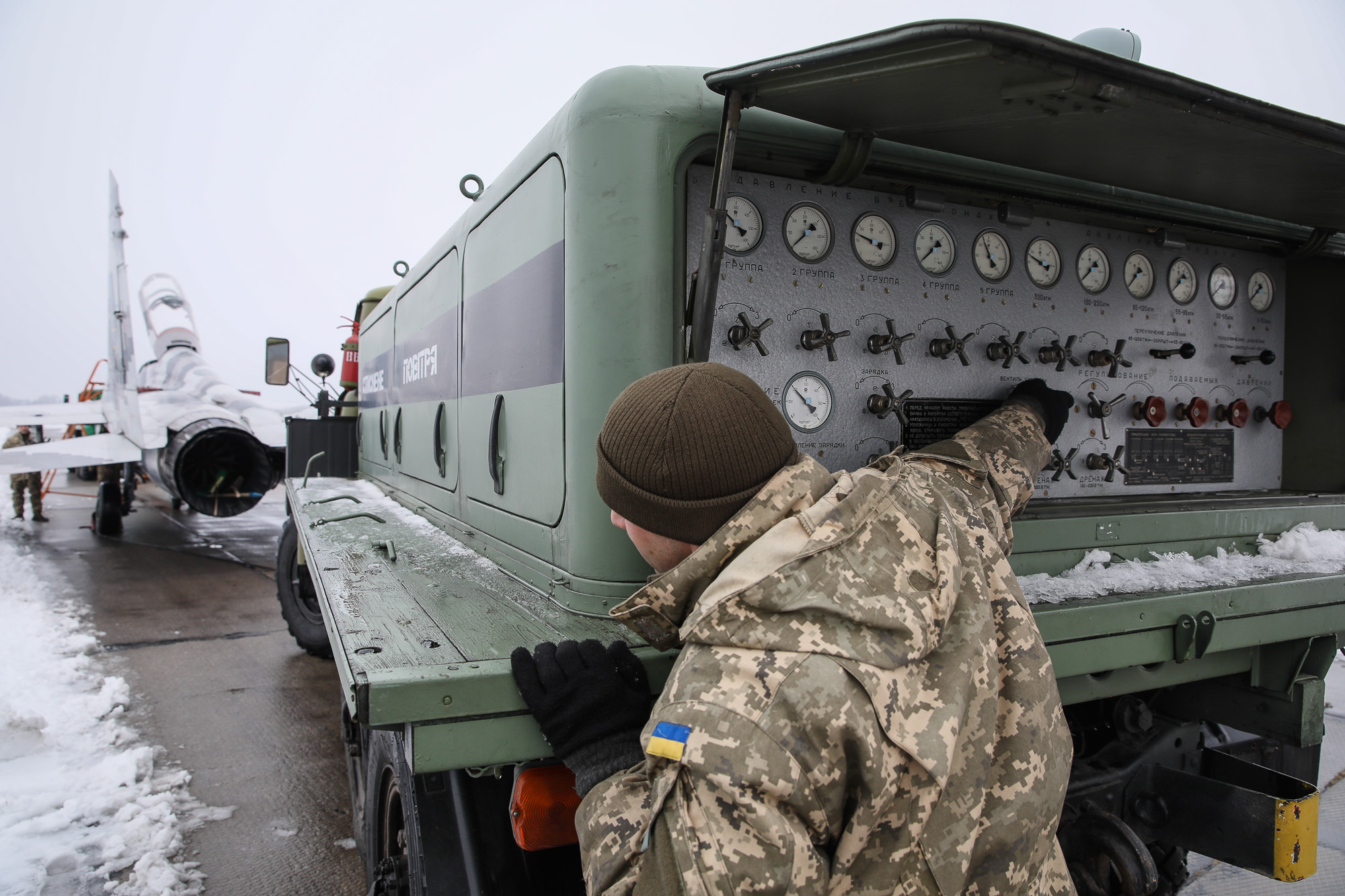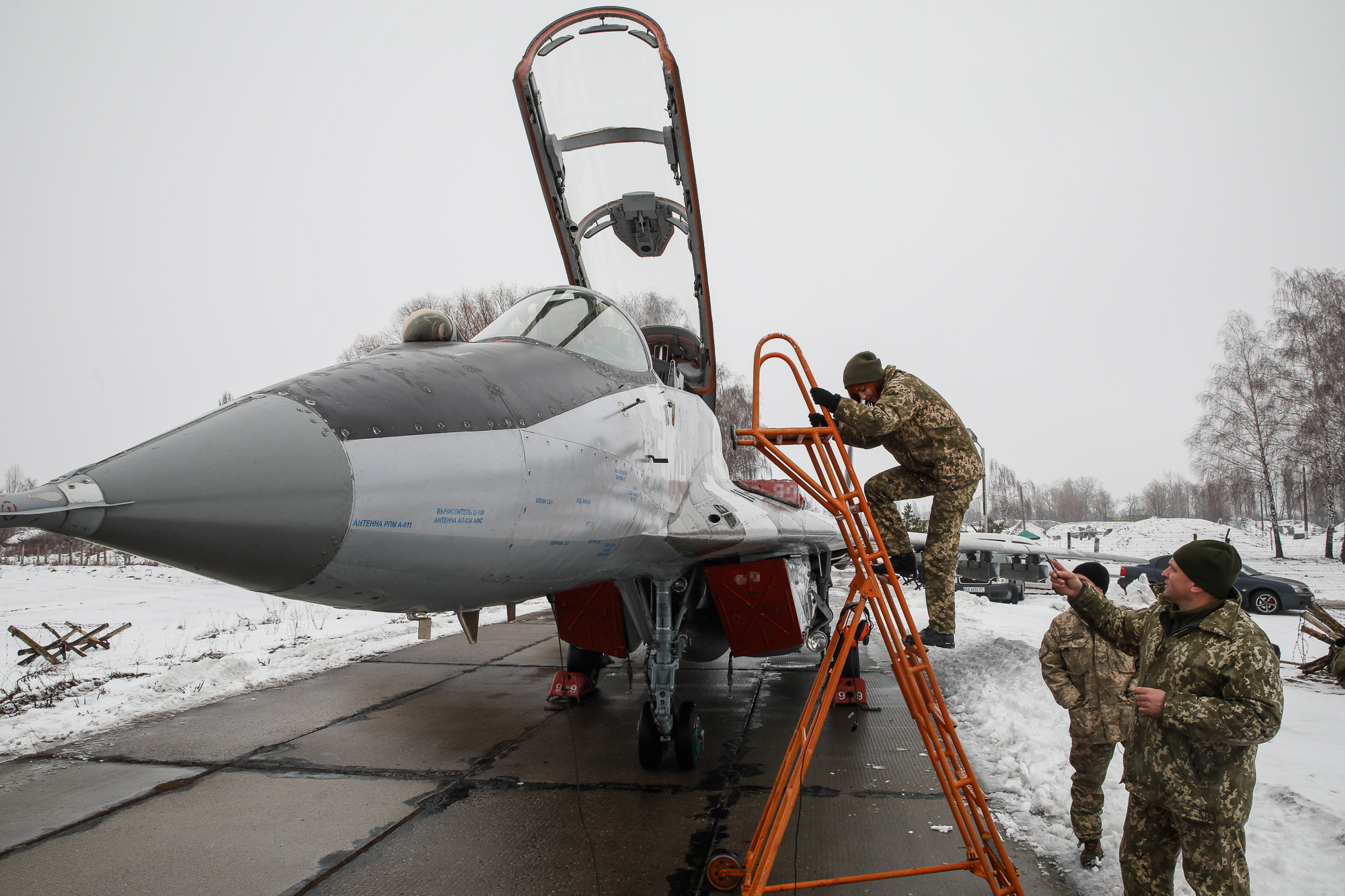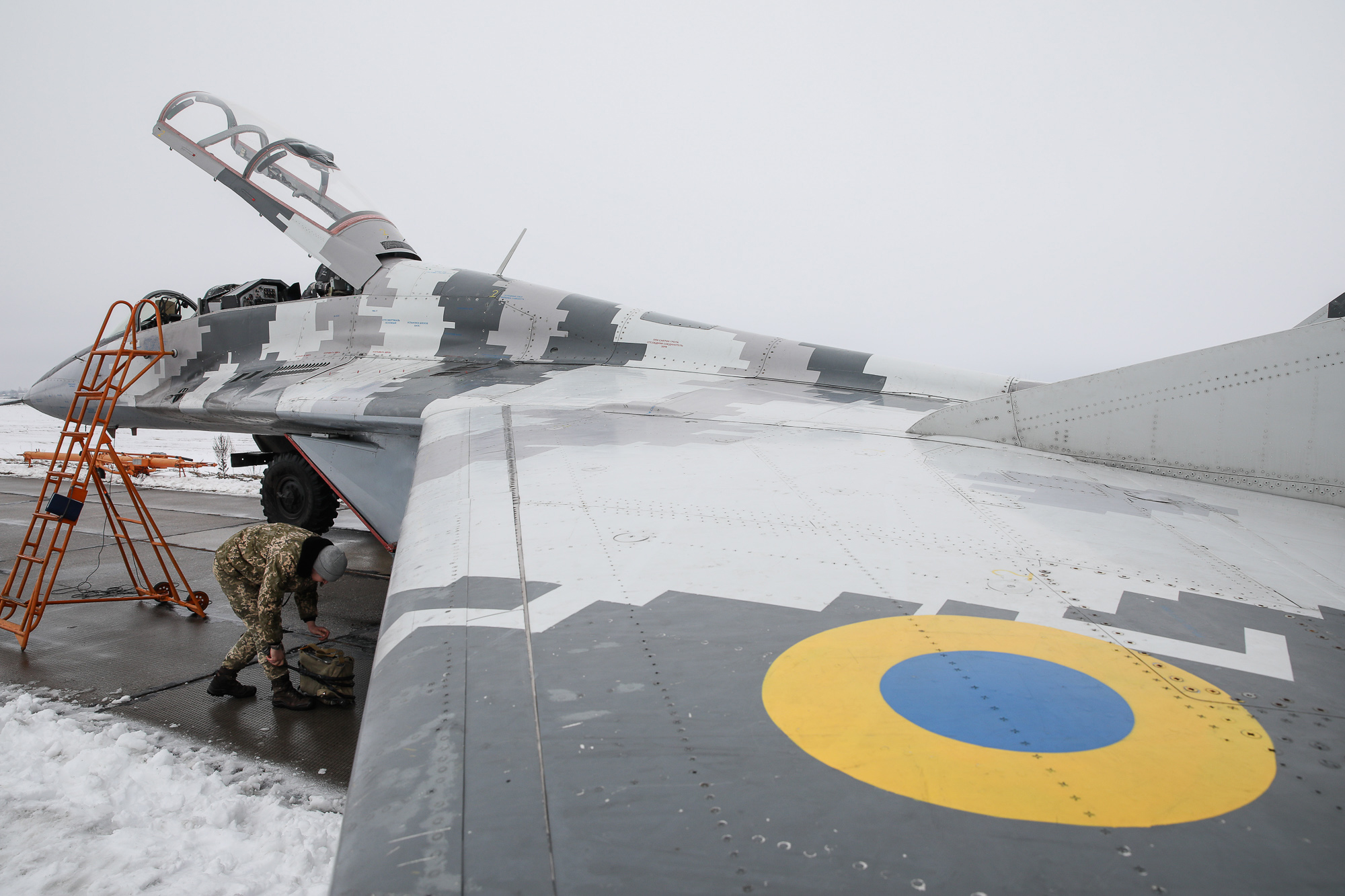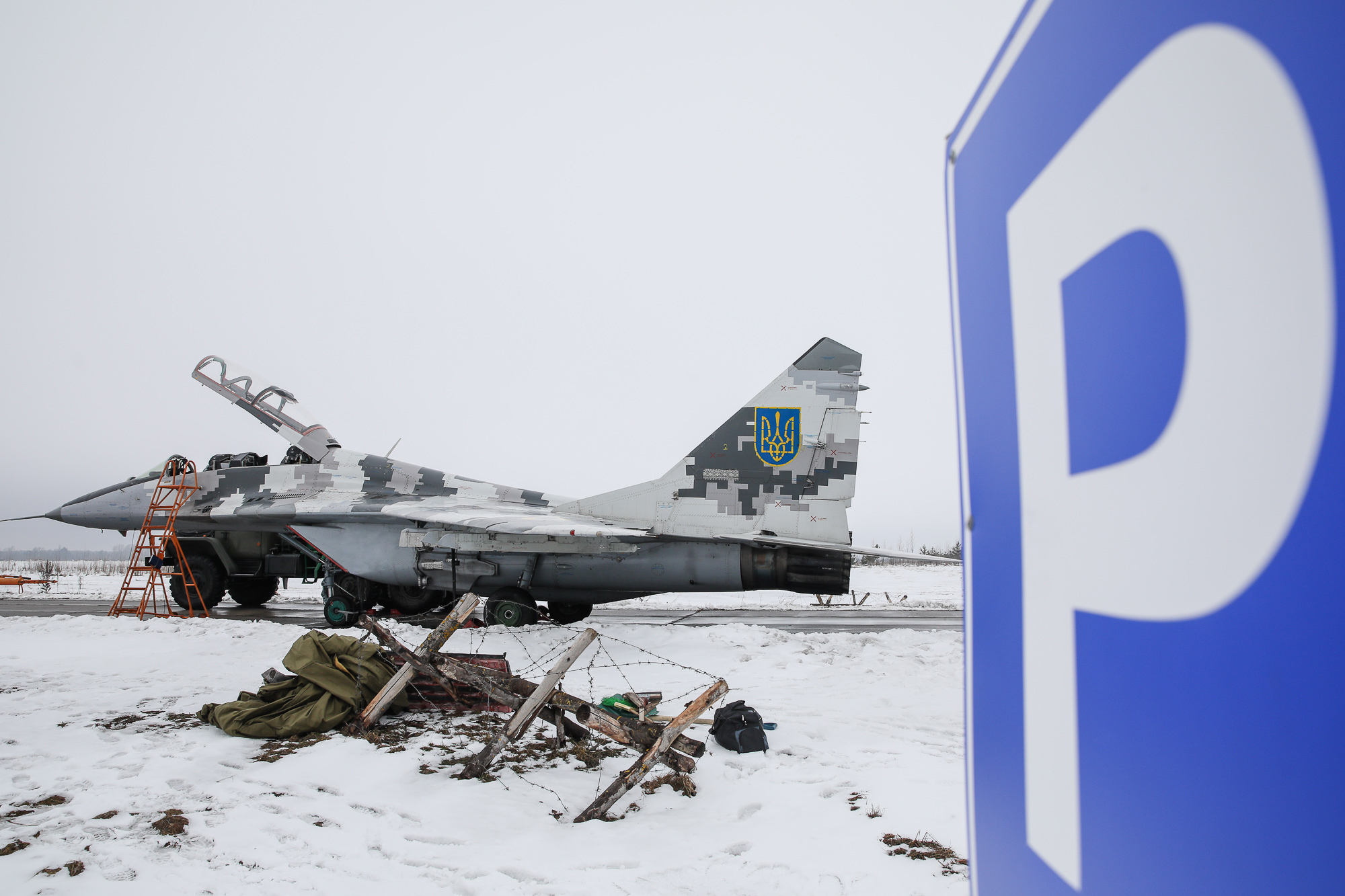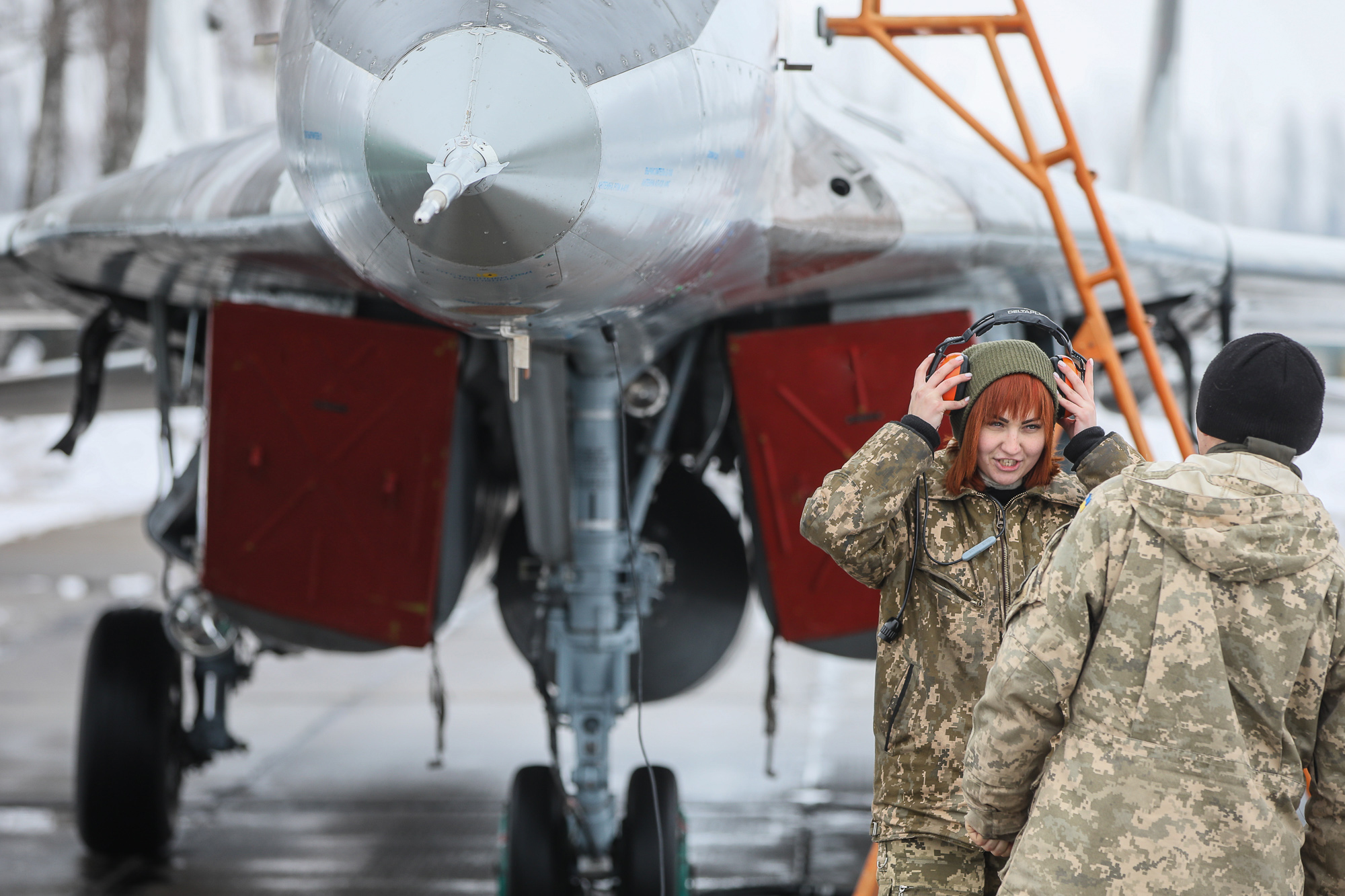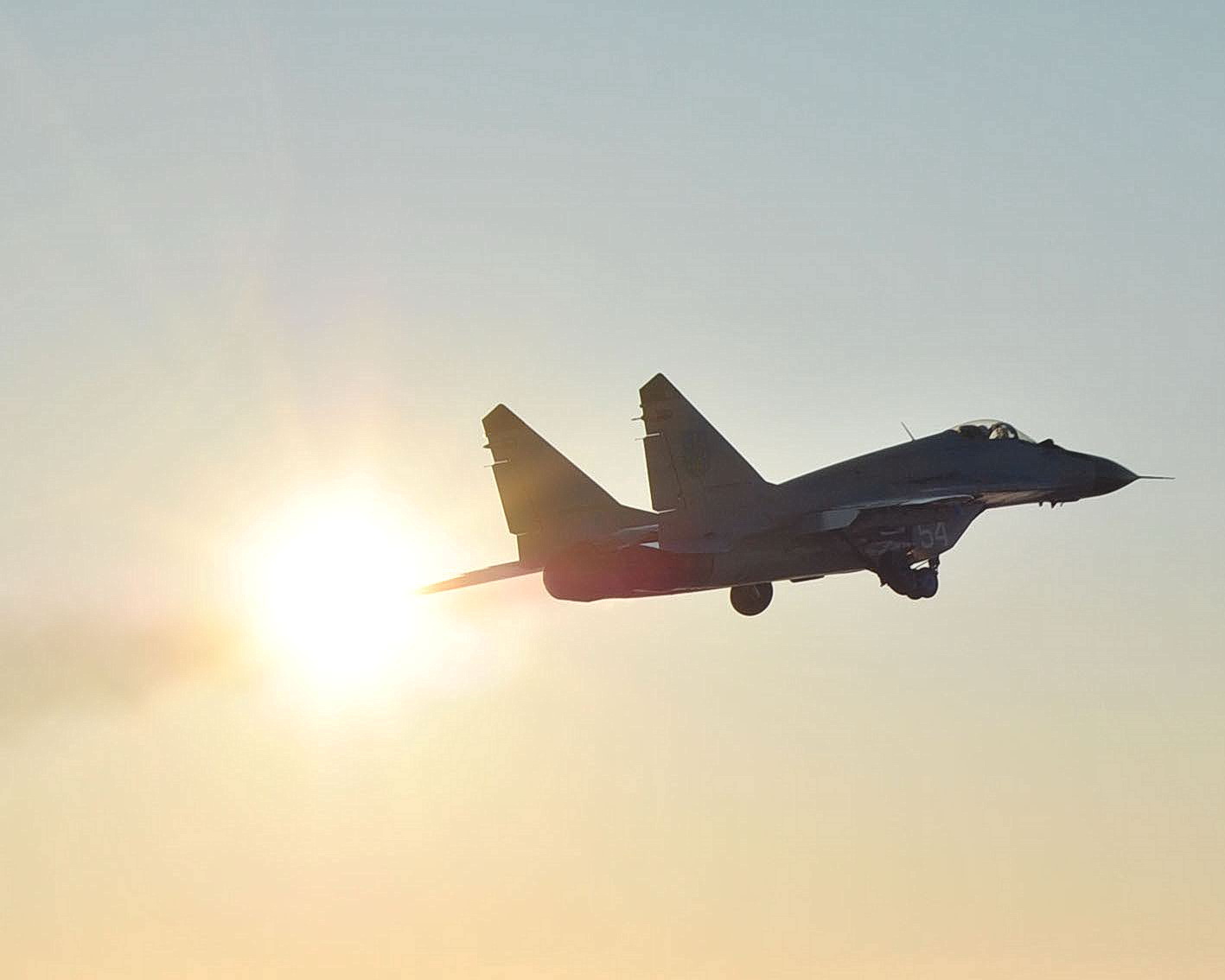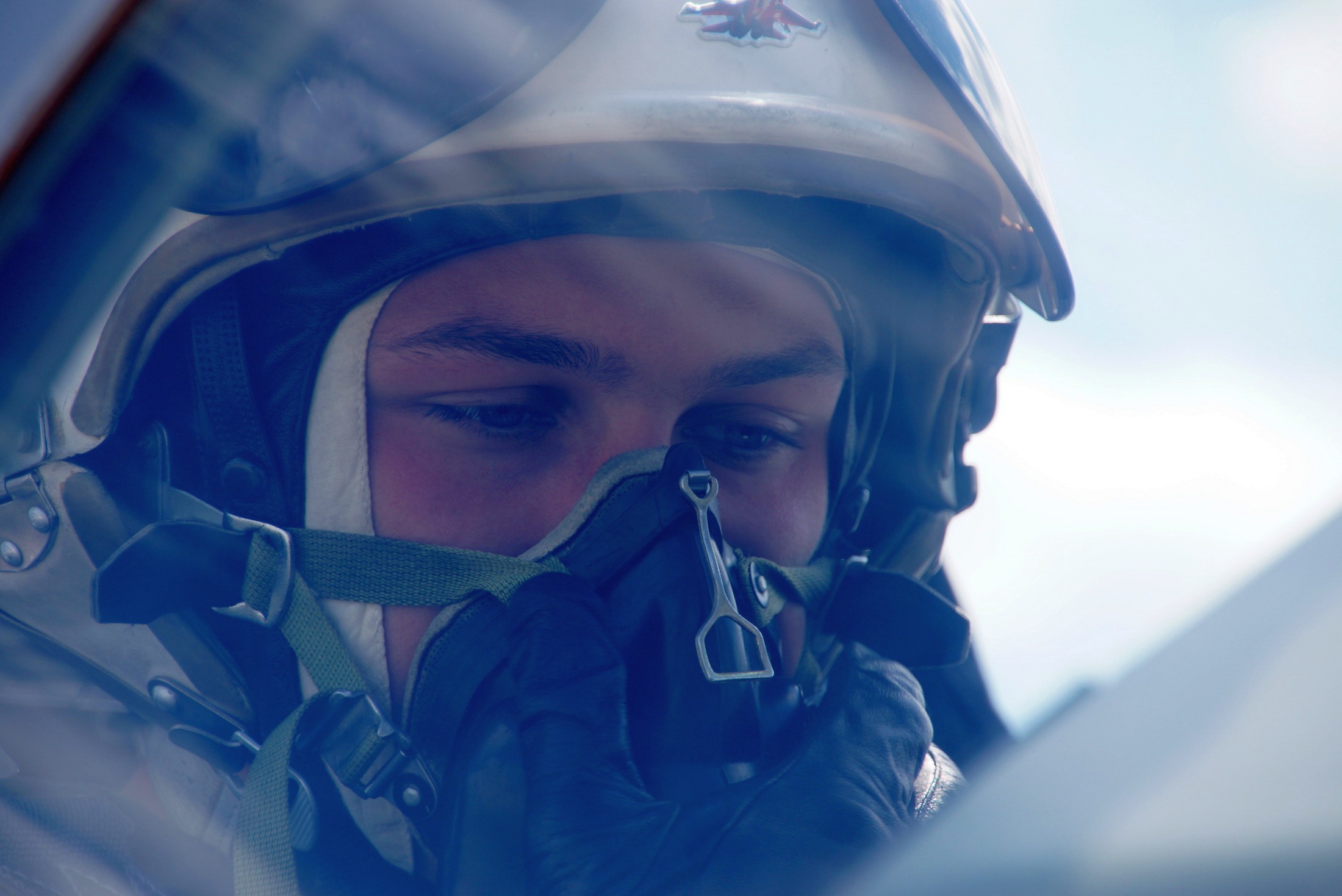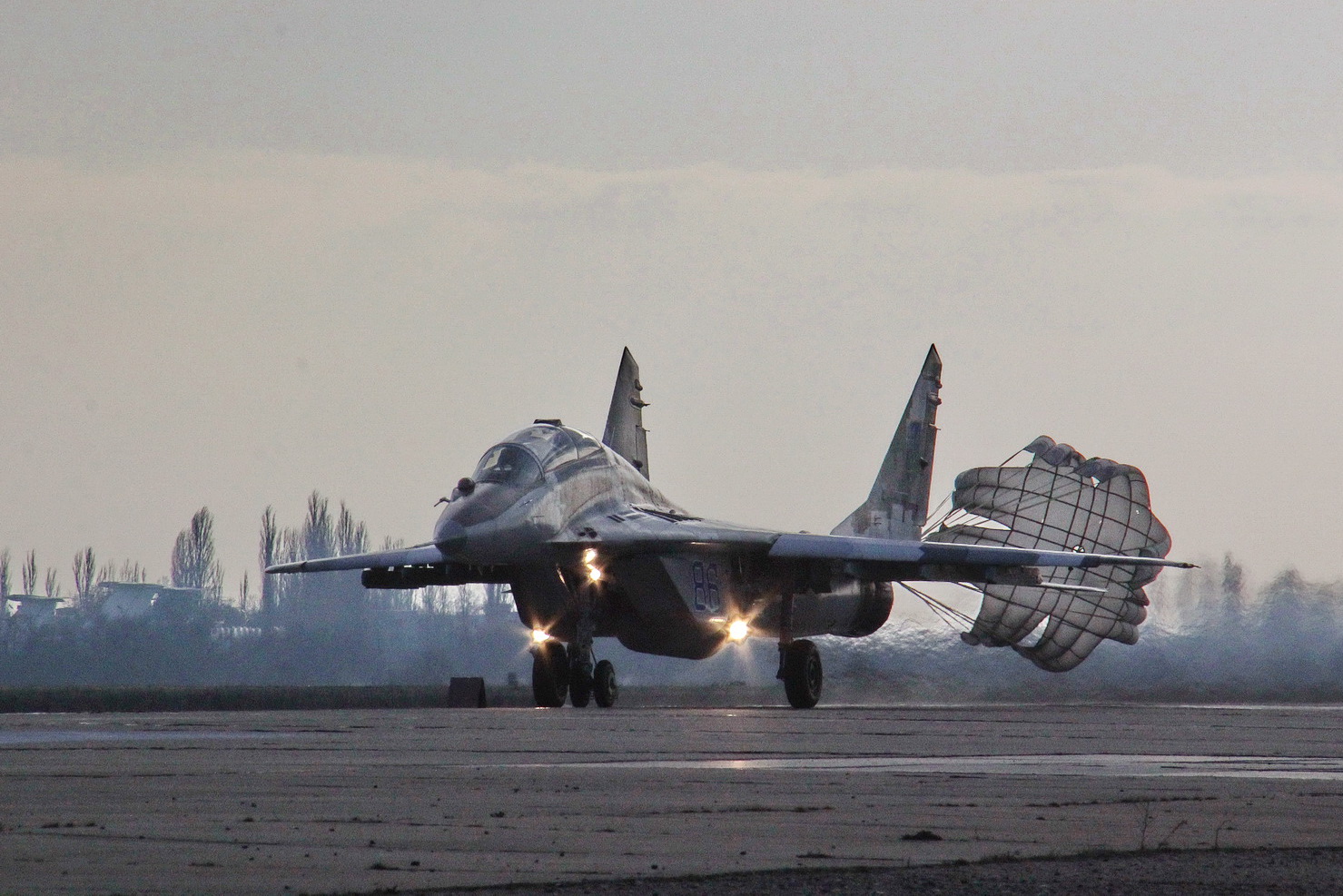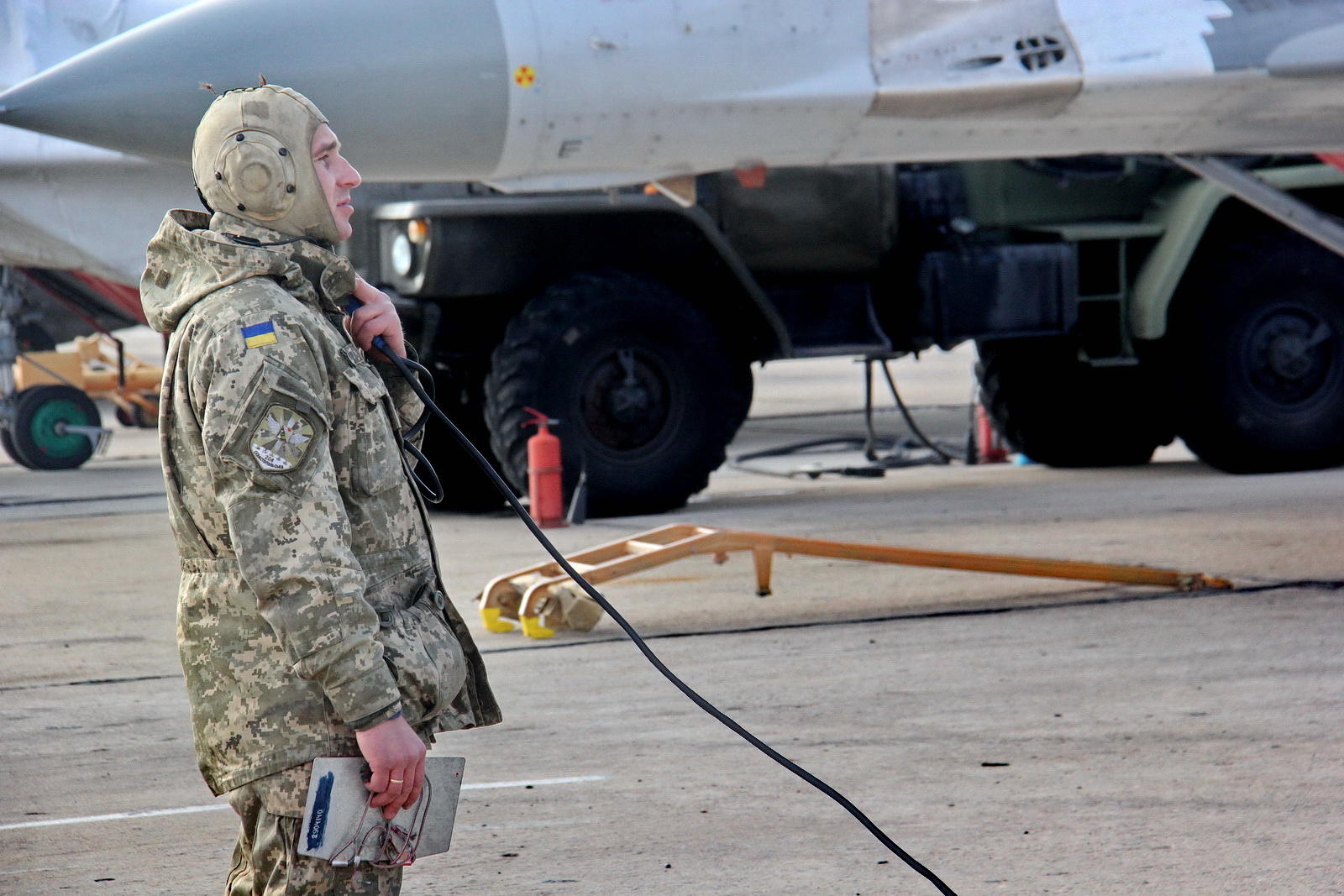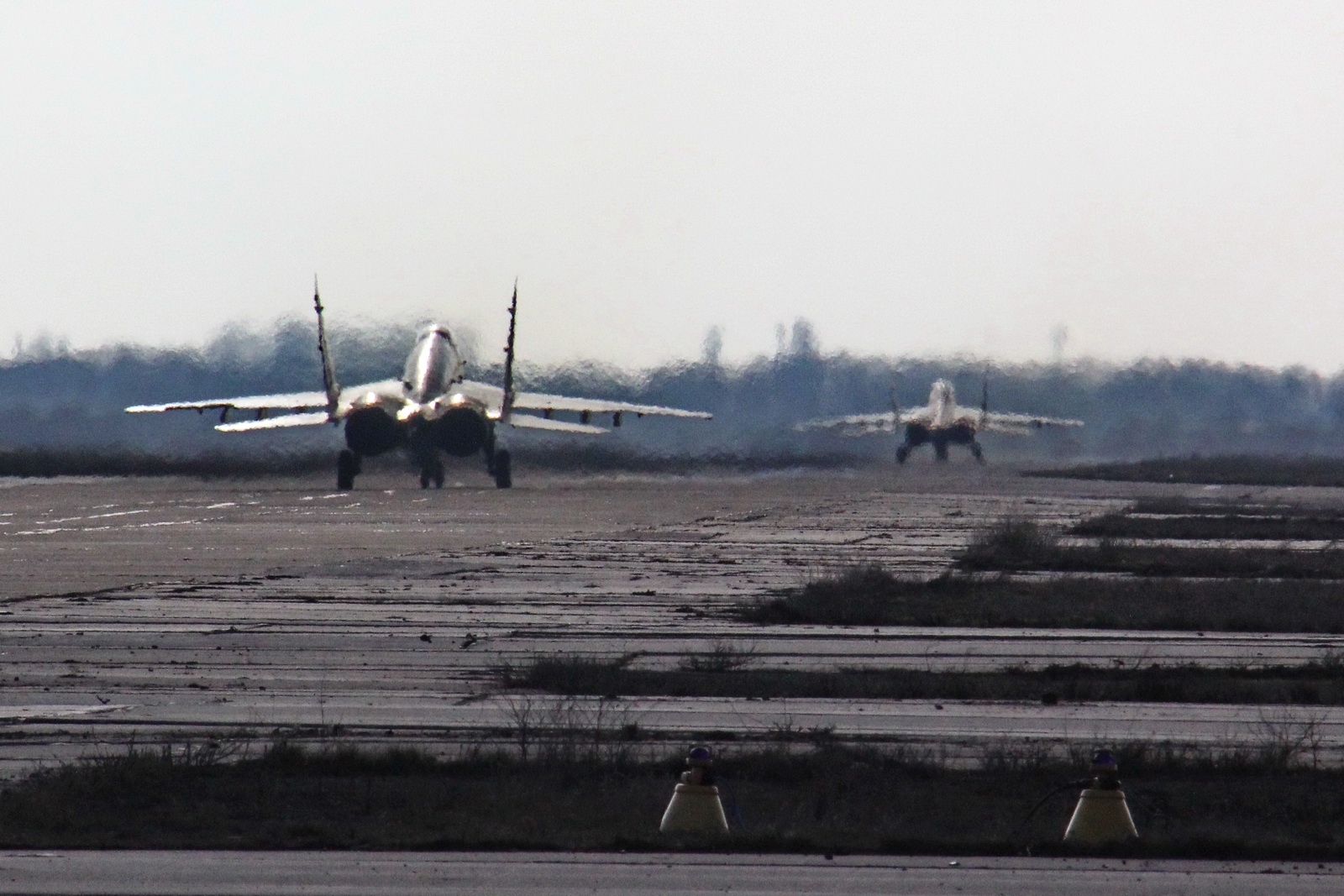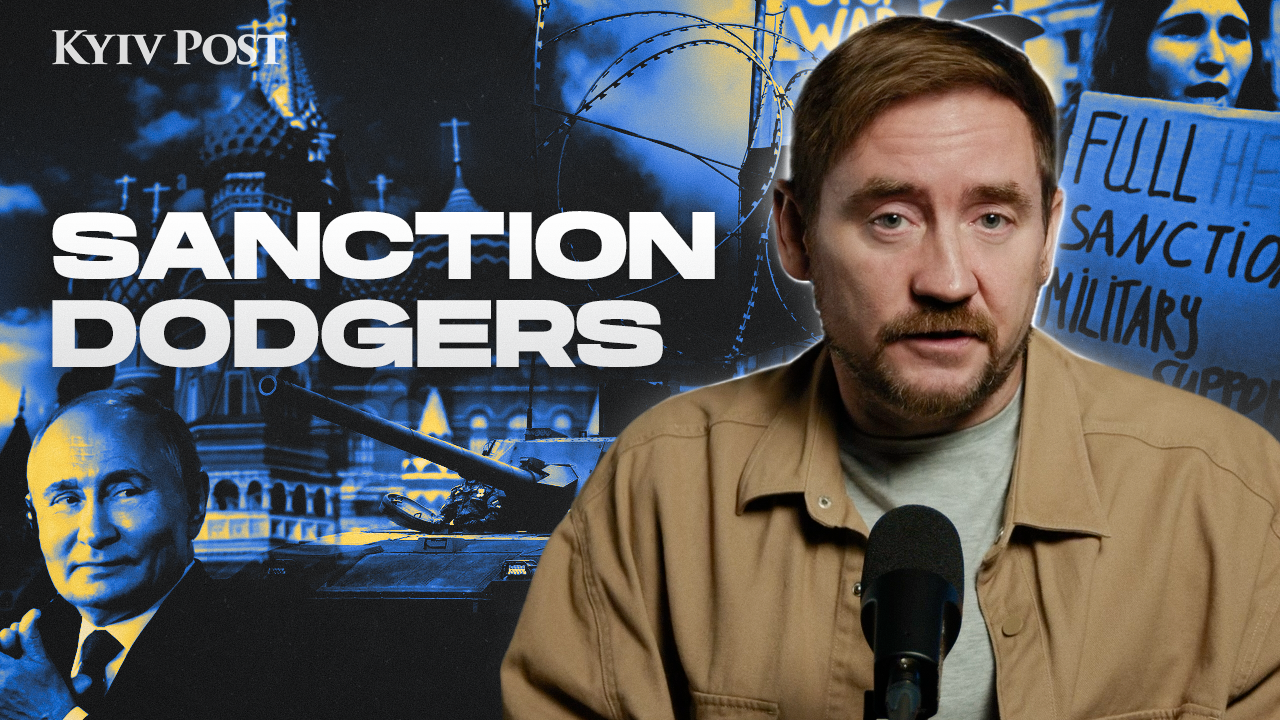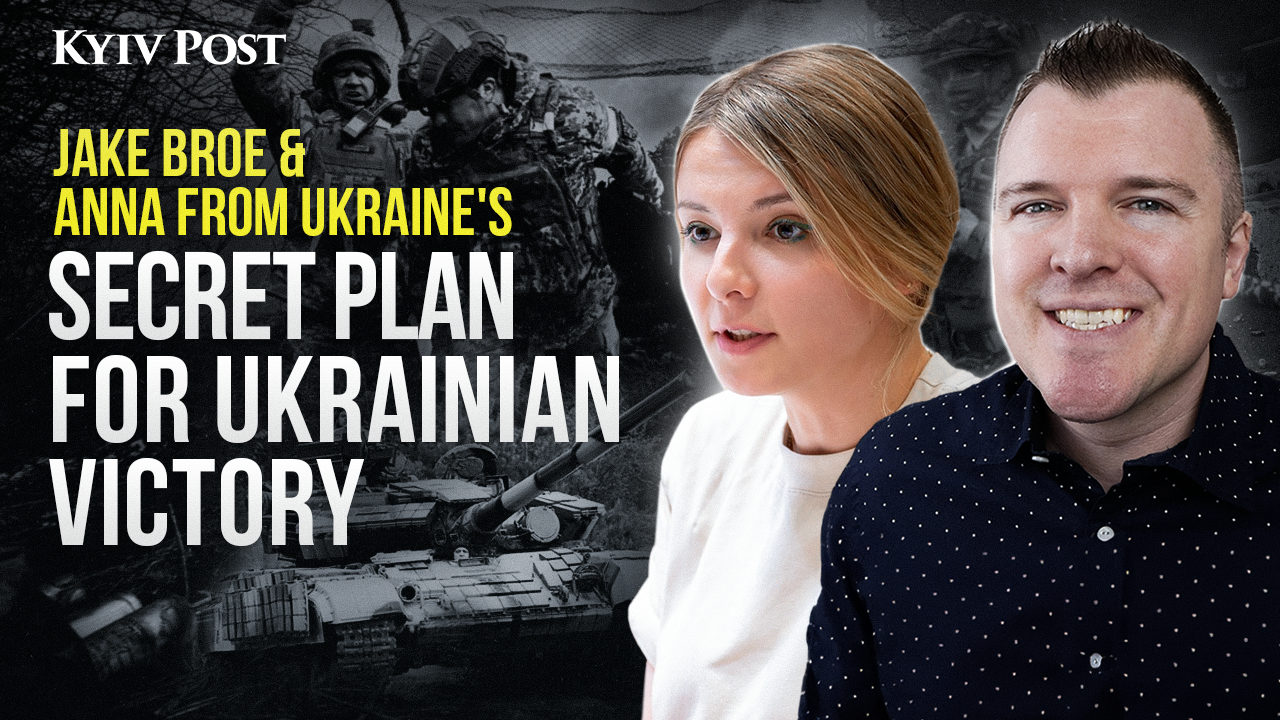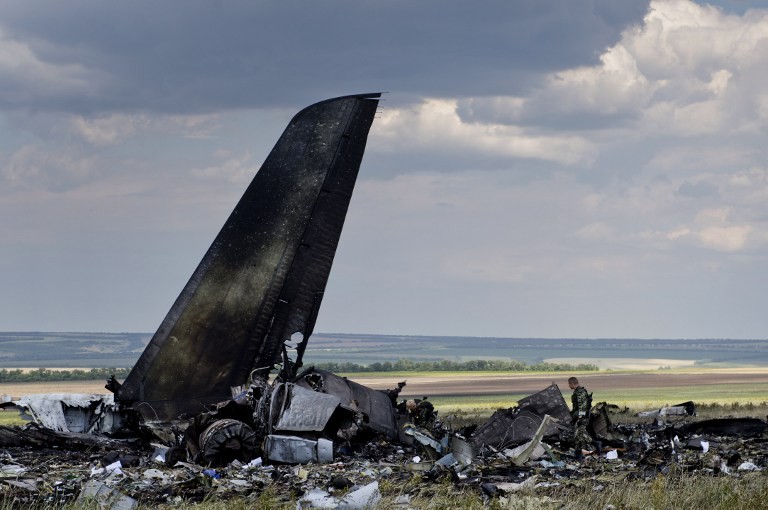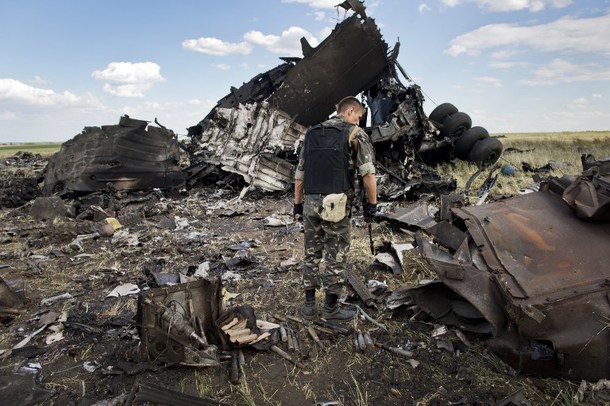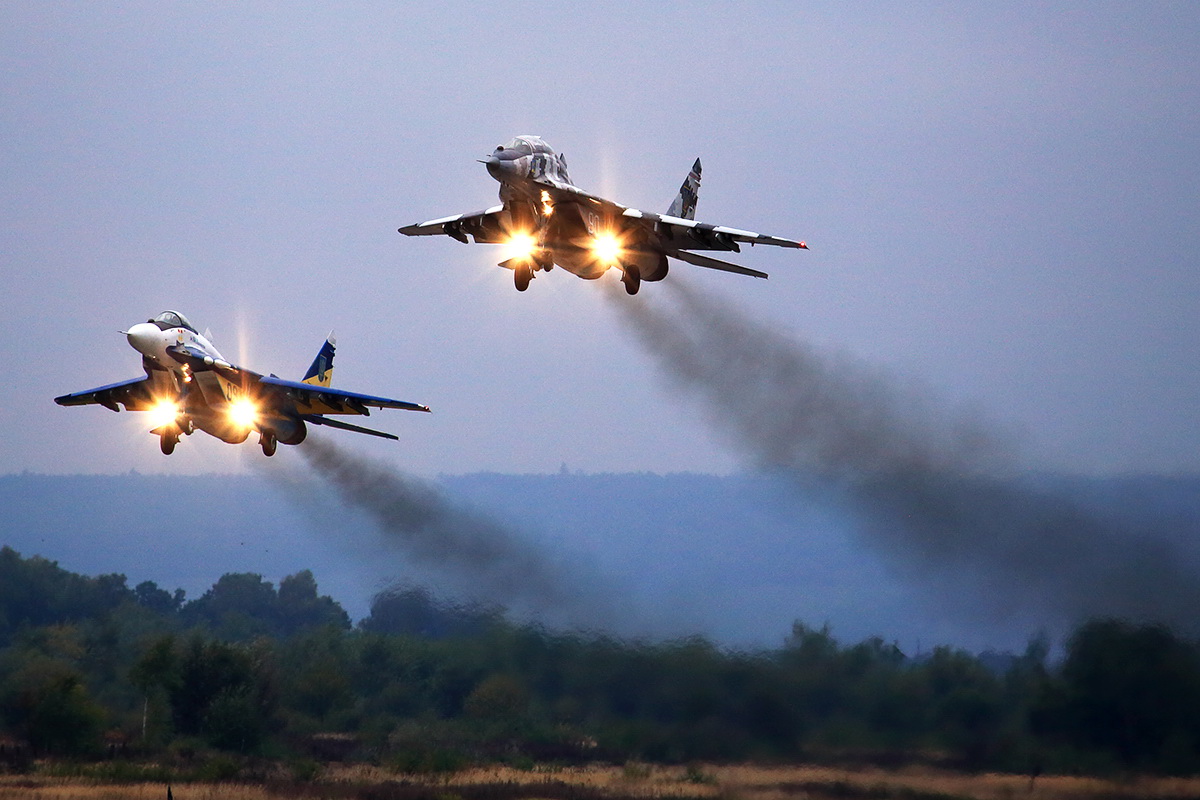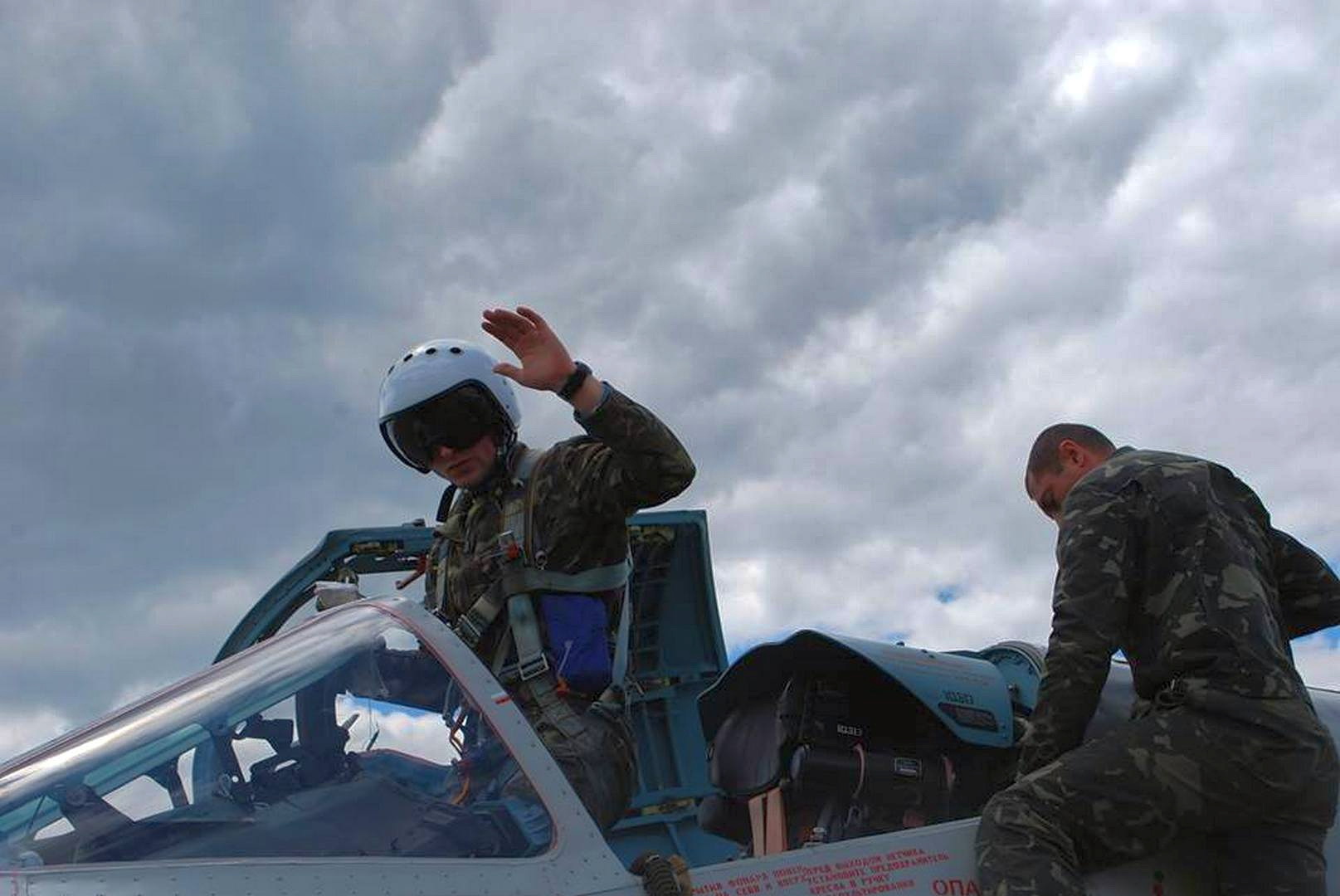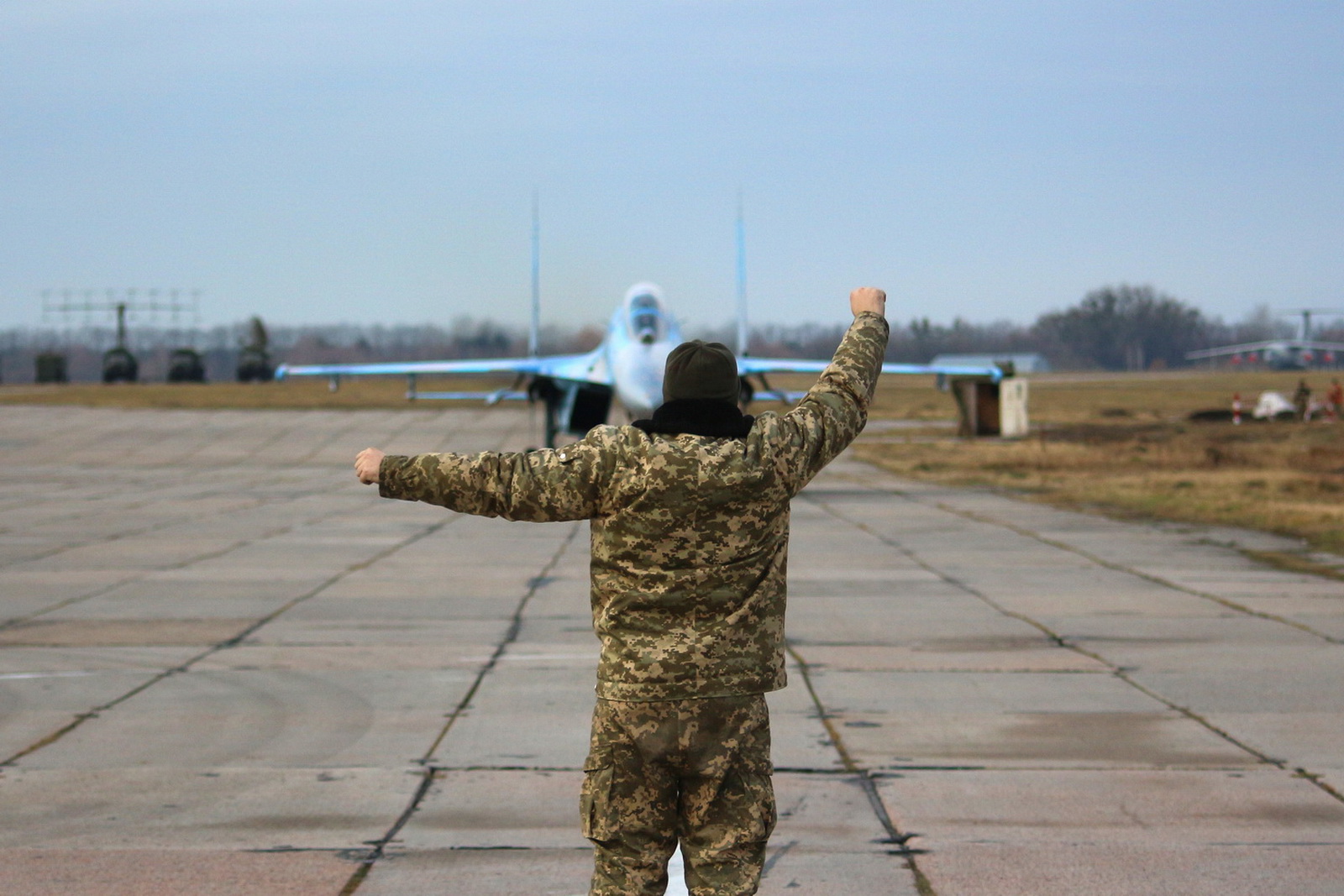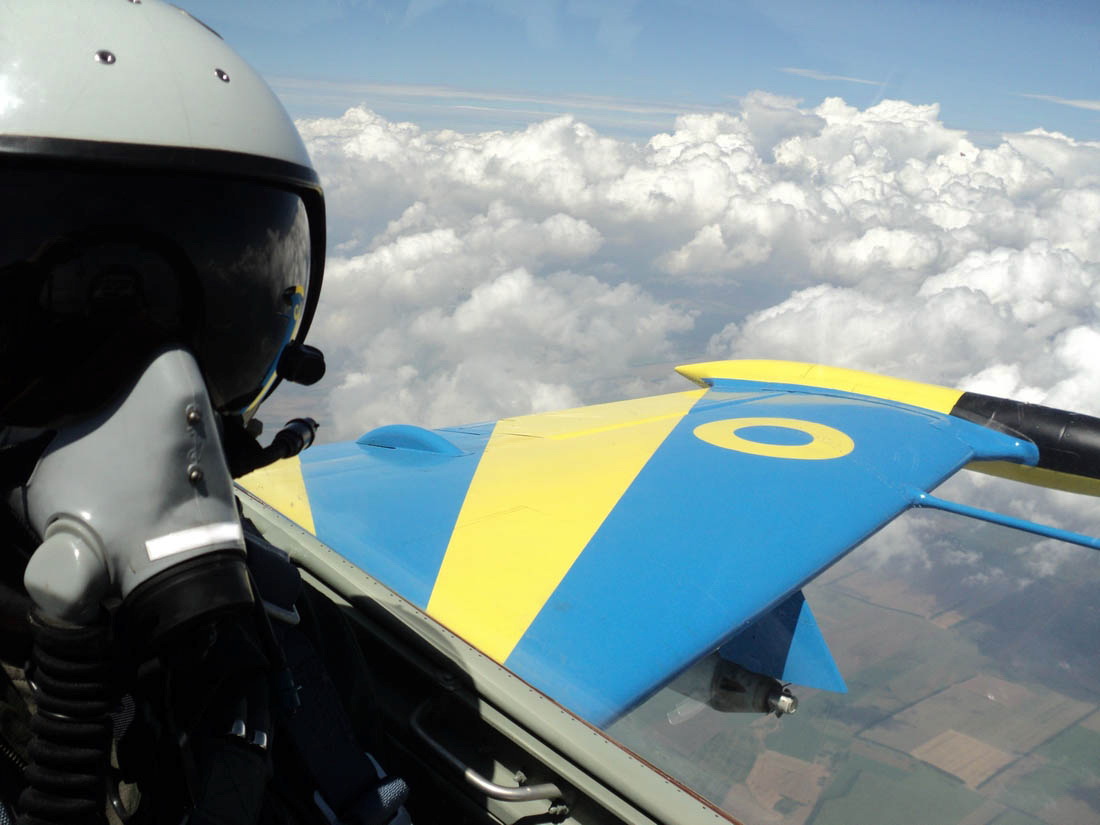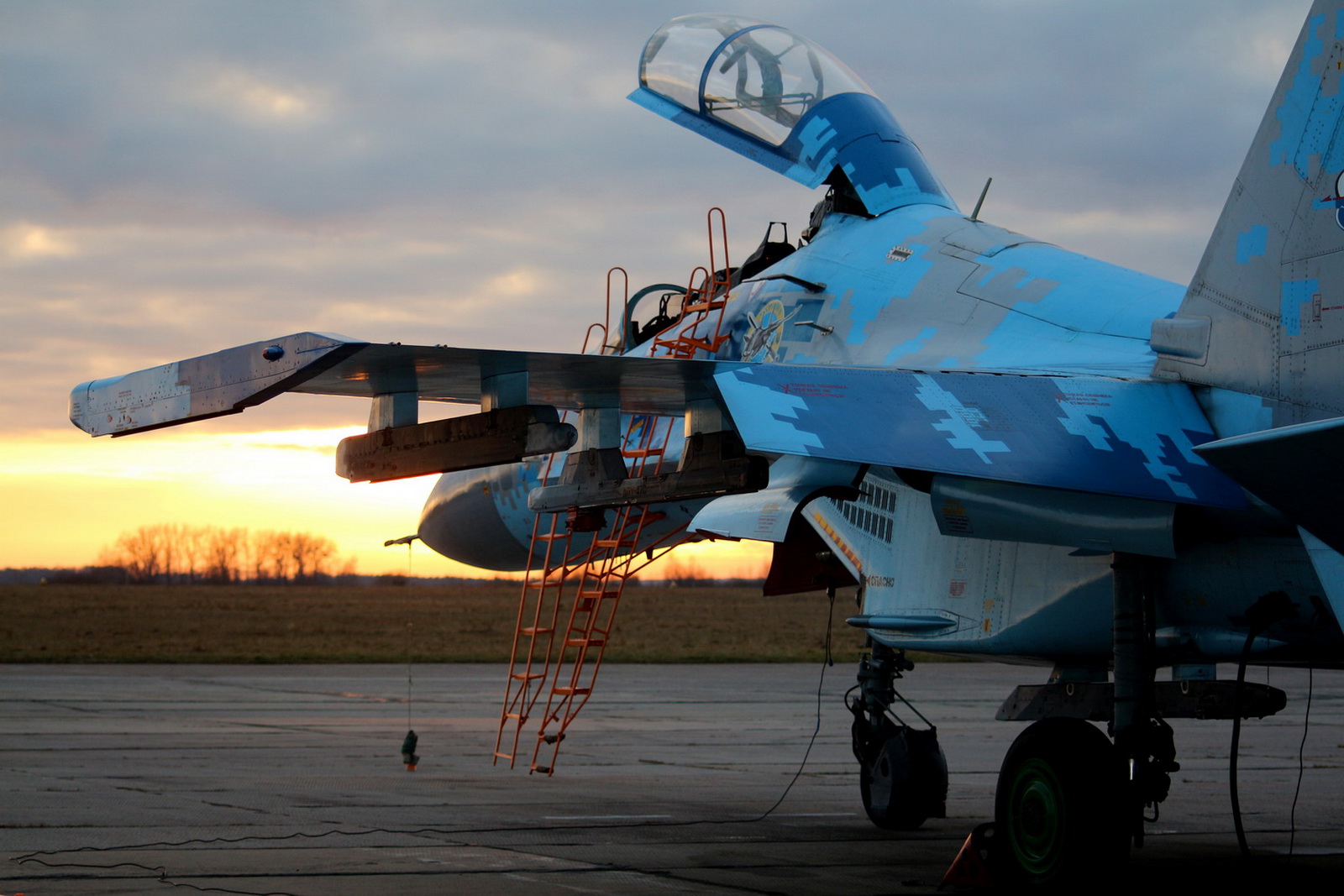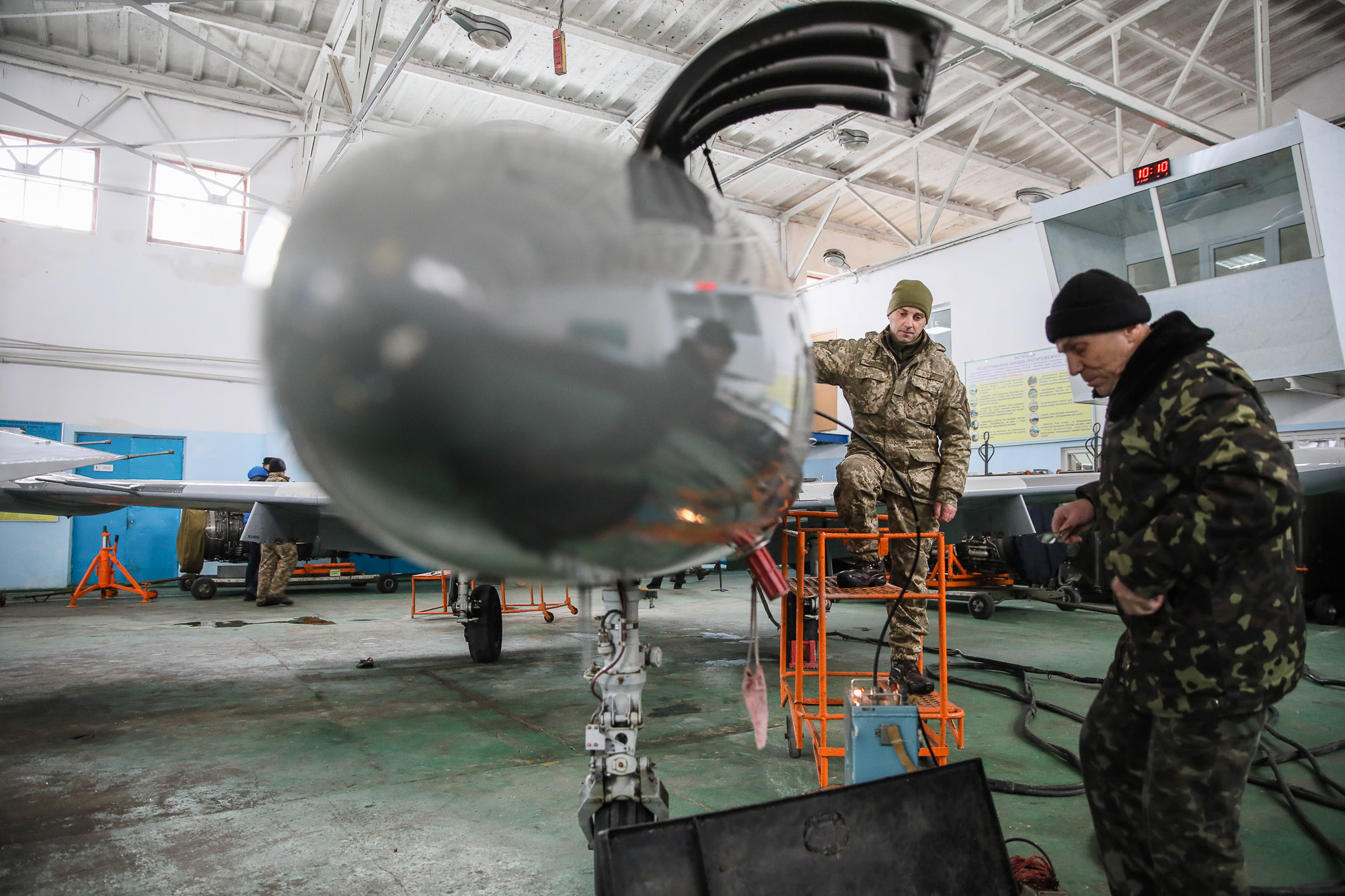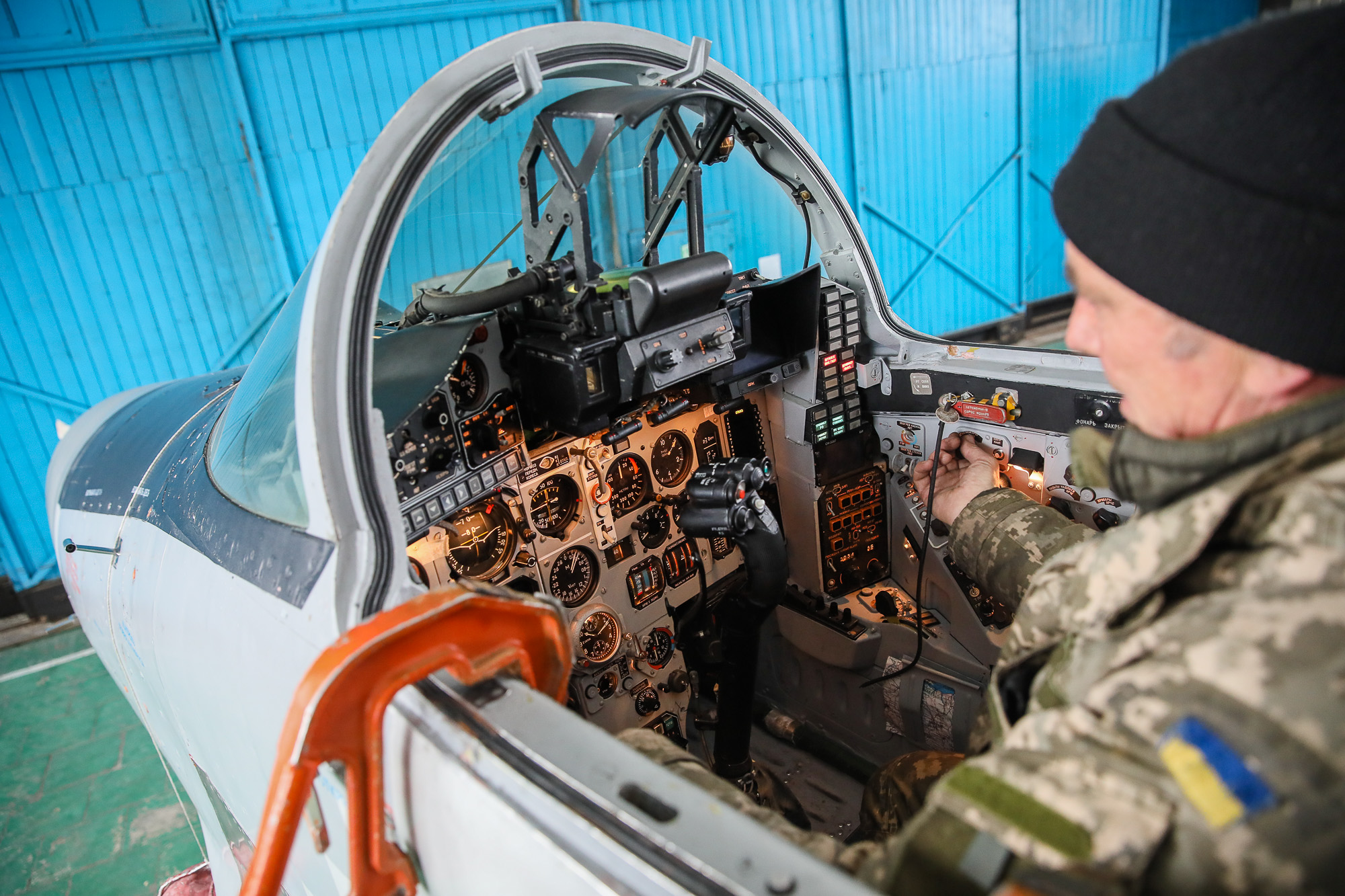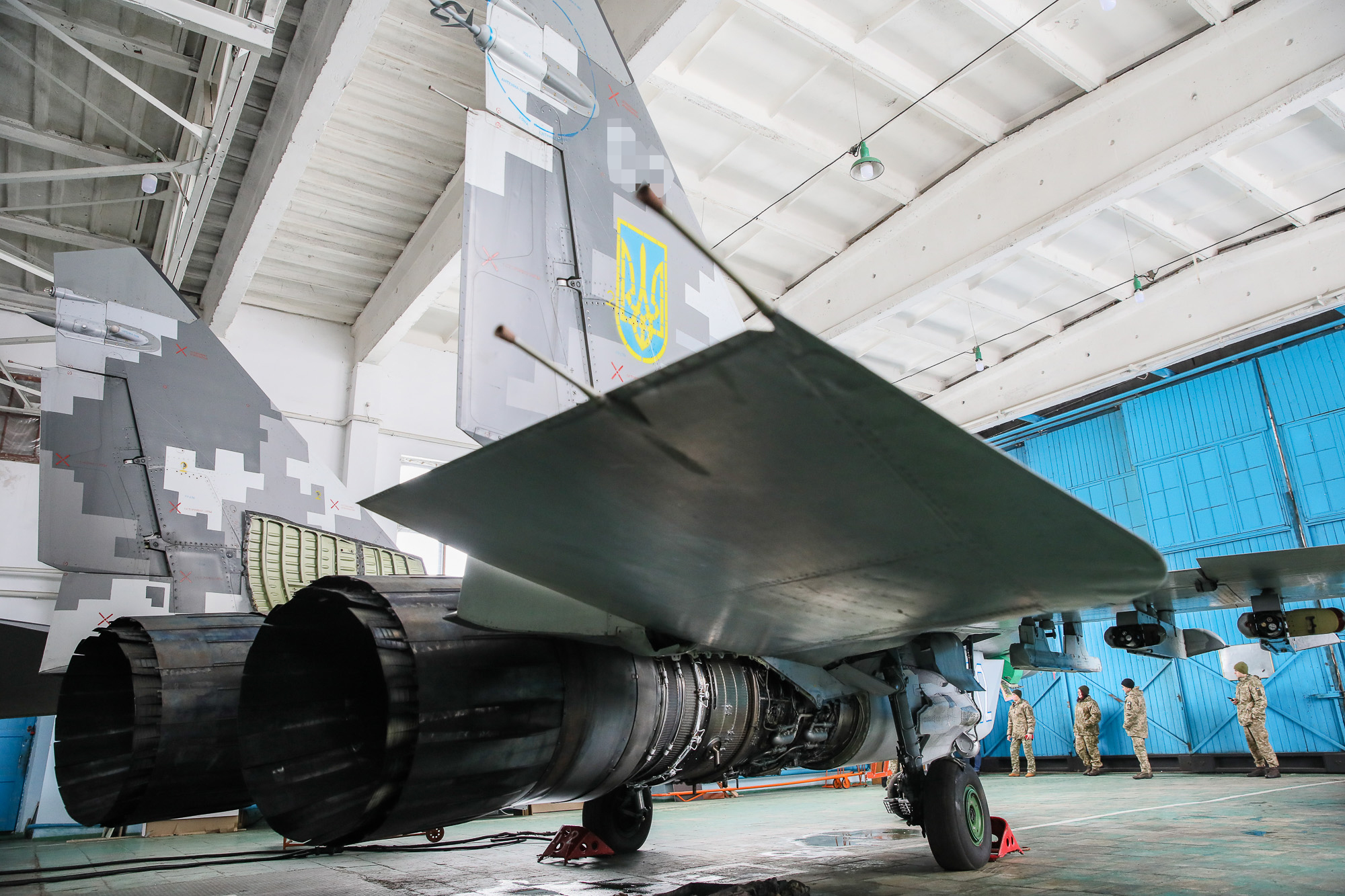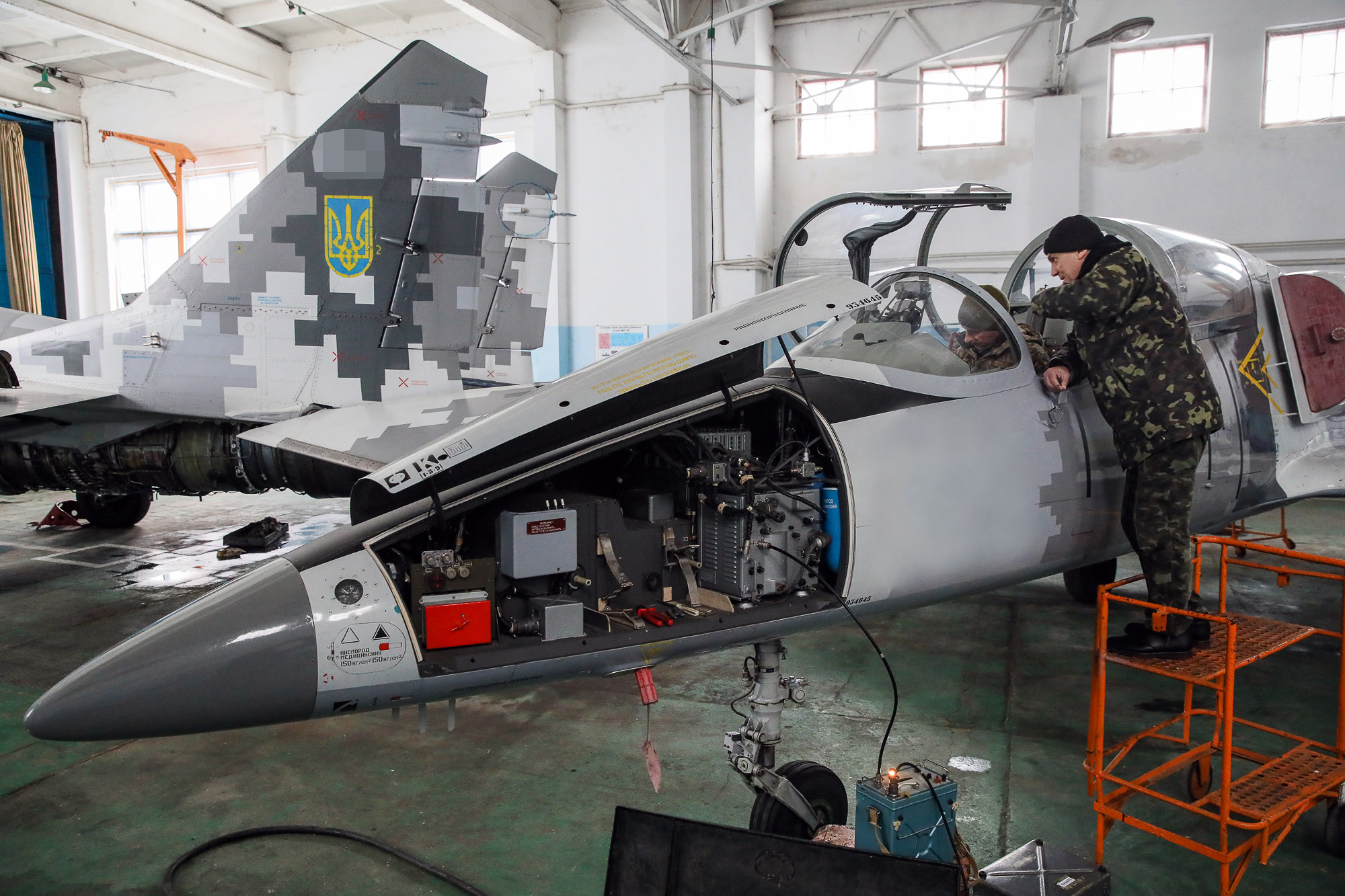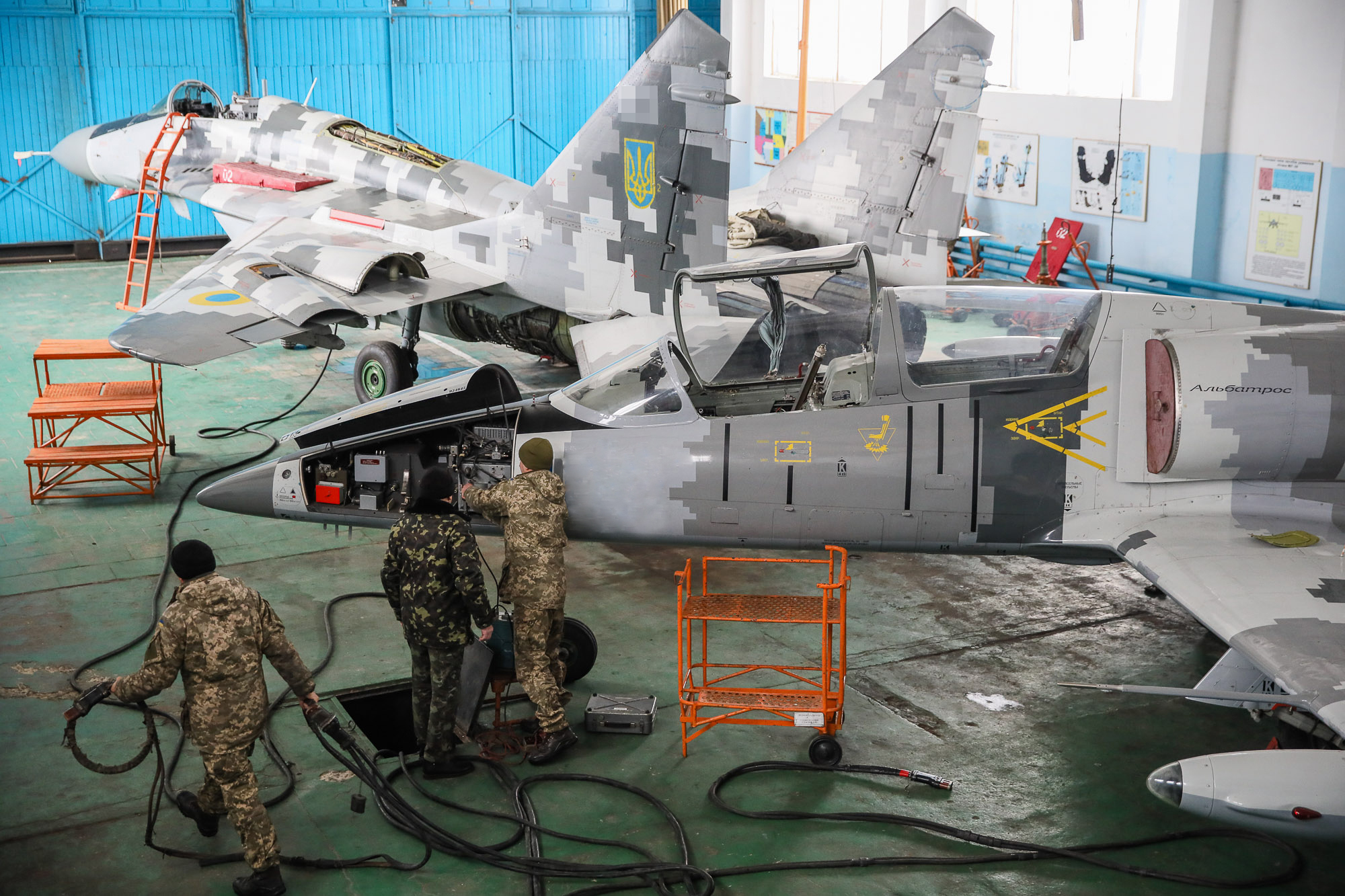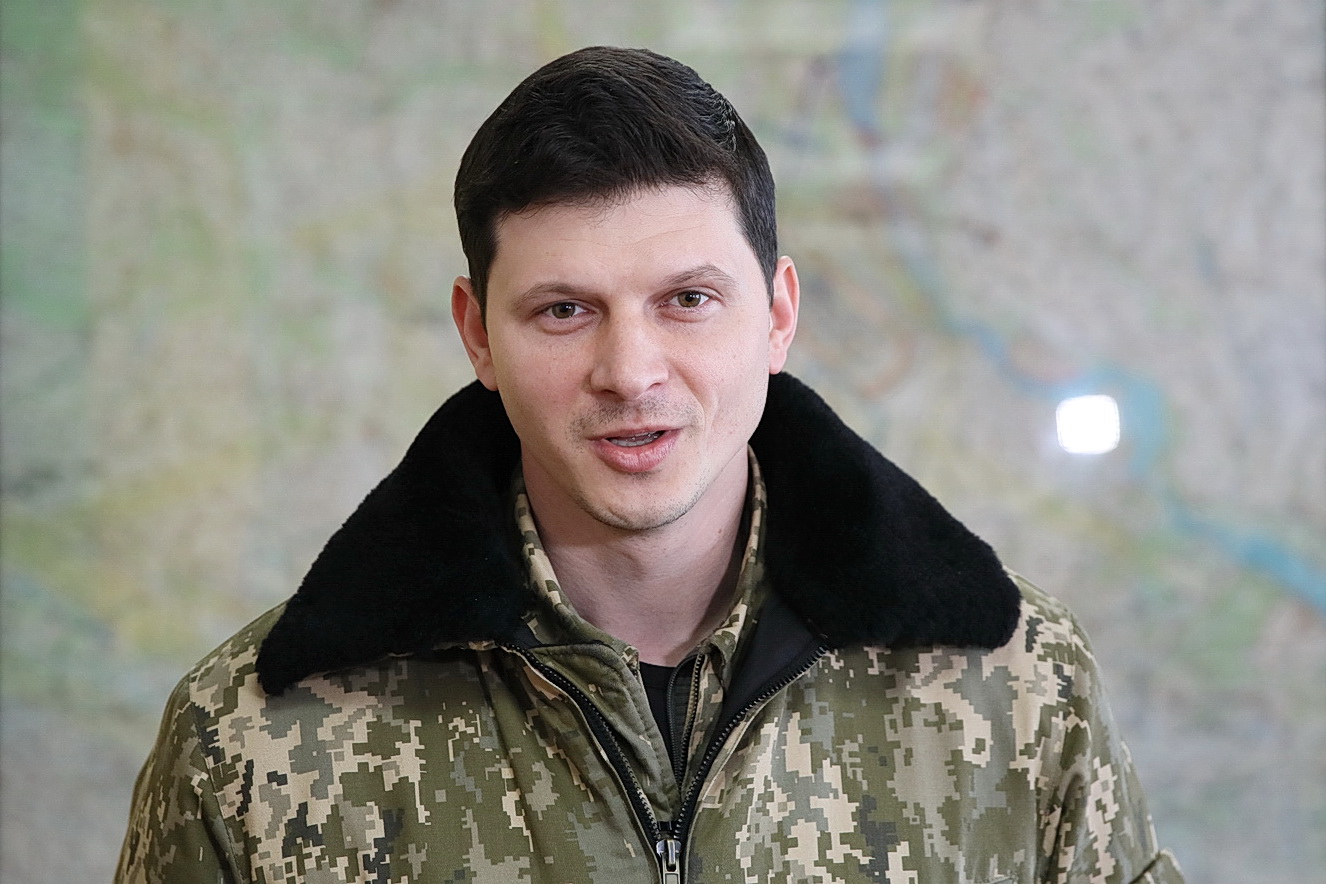VASYLKIV and VINNYTSIA, Ukraine — On a chilly morning in early spring, humid mist and low clouds hang over the air base of Vasylkiv, a city of 36,000 people located 30 kilometers southwest of Kyiv. It is home to the Ukrainian Air Force’s 40th Tactical Aviation Brigade.
By midday, the sky has cleared, and to the great joy of the brigade’s pilots, the base’s flight control center gives the go-ahead for a flight session — for the first time in this week of poor weather.
The session starts with meteorological reconnaissance — a silver Mikoyan MiG‑29 fighter with blue-and-yellow tridents on its twin tail fins is towed to the runway.
After a half-hour of tinkering, the senior service technician reports that the aircraft is fully fueled and ready to go. The pilot locks the glass dome of his cockpit, and the jet slips in the gray skies, its turbofan engines roaring and spitting trails of hot smoke.
The Ukrainian Air Force or UAF regularly conducts such practice flights these days, but this was not always the case.
During their careers, many Ukrainian pilots were frequently grounded for want of jet fuel, while their warplanes were being scrapped or sold off by the dozen.
But country’s rising defense budget, which has been skyrocketing since 2014 to a record-breaking $8 billion planned for 2019 – almost 6 percent of the nation’s gross domestic product — has offered them hope.
Crippled by years of underfunding, drastic post-Soviet cuts, and a rapid loss of skilled personnel, the UAF is trying to rise again as a combat-potent force. The mission is now to prevent Russia, the world’s second greatest air power, from encroaching on Ukraine’s integrity and independence.
With swarms of Russian warplanes based closer to Ukraine’s borders every month, the UAF is now feverishly training more pilots and modernizing their aircraft. But its aging fleet, inherited from Soviet times is drawing close to the end of its operating lifetime.
Within the next decade, the UAF needs a new fleet of modern warplanes capable of conducting a full spectrum of military operations — otherwise, Ukraine’s skies will be largely defenseless.
Fall from grace
In 1991, independent Ukraine emerged as the world’s third largest air power, trailing only the United States and Russia.
It inherited an impressive Soviet air fleet of over 2,000 warplanes, including 44 Tu‑22 and Tu‑160 heavy strategic bombers, divided into four air armies operated by 122,000 military personnel and 27,000 civilian staff.
The air fleet was capable of fulfilling all sorts of combat tasks, including delivering tactical nuclear weapons and conventional guided and non-guided weaponry.
But the following years brought nothing but decay and cuts. In compliance with the 1994 Budapest Memorandum, Ukraine got rid of its nuclear stockpile and disposed its strategic bombers by 1998, under security assurances from Russia, the United States, and the United Kingdom.
Other aircraft were sold off by the dozen. Between 2007 and 2017 alone, according to figures provided by the State Service of Export Control, Ukraine sold as many as 65 combat jets (Su‑27s, Su‑25s, and Su‑22s, MiG‑29s and MiG‑21s), 41 L‑39 Albatros trainer aircraft, six An‑72, An‑74, and An‑12 military transport aircraft, three Il‑78 tankers, 50 Tu‑143 reconnaissance drones, 44 Mi‑24 and Mi‑24 helicopters, and 802 missiles of various types (mainly R‑24, R‑27 and R‑73 air-to-air missiles, and the Kh‑59 air-launched cruise missile).
The years of sales brought the state millions of dollars, but since 1991 the UAF has not received a single new aircraft.
Riding the storm
Worse yet, budgets in all areas — from training to routine servicing — were tiny.
“In the early 2000s, young pilots were graduating the Kharkiv Air Force University with very weak flight experience,” Lieutenant Colonel Yuriy Ignat, a UAF spokesman told the Kyiv Post.
“We had to give them support jobs on the ground. There was barely enough fuel for commanders and instructors, far less for the young pilots. We had a situation when senior officers — from squadron leaders to brigade commanders — were the only ones to perform national air defense flights.
“It was just survival. Modernizations and overhauls were completely out of the question.”
Severe personnel cuts and the closure of entire air command headquarters continued too. According to the Military Prosecution Office, as many as 19 UAF units were disbanded in 2012–2014 alone. This eventually led to Ukraine’s air power being totally paralyzed in the wake of Russia’s invasion of Crimea in early 2014.
The surrender in Crimea was a devastating blow to the UAF. It lost its best infrastructure in the peninsula and as many as 126 aircraft. Ukraine later managed to recover only 92 of the planes — the Russians decided to keep the rest.
But worse — the Kremlin’s proxy war in the Donbas — was yet to come.
Despite an obvious lack of practice and modern equipment, Ukrainian air power played an important role in early battles of Slovyansk and Kramatorsk in the spring of 2014, as well as in the bloody fighting for Donetsk Airport and Ilovaisk.
The lowest point in the UAF’s history came overnight into June 14, 2014, when an Il‑76MD military transport plane was downed by Russian-led forces over the Luhansk Airport. All 49 men on board, including 40 paratroopers and 9 crew, were killed in the crash.
The dramatic months of 2014 created modern air force heroes — such as Lieutenant General Vasyl Nikiforov, who early in the war called up a dozen of his old friends, retired veteran pilots, to drill youngsters in fighting the invaders, or Major Vladyslav Voloshyn, who survived being shot down behind enemy lines during the battle of Ilovaisk.
But the UAF’s active involvement in the war effectively ended in early September 2014, when, after the crushing defeat and slaughter of Ukrainian forces by Russian regular troops at Ilovaisk, Moscow made a total ban on the use of air power a precondition for the first Minsk peace agreement.
During the war, Ukraine has lost 51 UAF servicemen, including 16 pilots.
Still going strong
Today, nearly 50,000 personnel serve in the UAF, now based in Vinnytsia, a city of 370,000 people located 200 kilometers southwest of Kyiv.
According to the International Institute for Strategic Studies, a London-based research institute, the UAF now has nearly 125 combat-ready aircraft.
These include approximately 37 MiG‑29 and 34 Su‑27 fighters, 14 Su‑24M attack aircraft, 31 Su‑25 close air support aircraft, nine Su‑24MR and three Antonov An‑30 reconnaissance aircraft, 32 L‑39 training planes, and five Ilyushin Il‑76 and three An‑26 military transport aircraft.
The force also has a pool of 14 Mi‑9, 30 Mi‑8, and two Mi‑2 helicopters. Ukrainian skies are also guarded by 250 S‑300P/PS/PT and 72 Buk-M1 surface-to-air missile systems.
While today’s UAF is a shadow of what it was in 1992, Ukraine still remains among the few nations operating all principal branches of air power — bombers, fighters, attack aircraft, reconnaissance, transports, and drones, in addition to missile and electronic warfare forces.
Increased spending on air power, reaching a total of Hr 8.3 billion ($320 million) in 2019, has allowed the gradual resumption of regular practice flights. Ukrainian fighter pilots now get between 40 and 60 flying hours a year, and all airbases hold two or three flight sessions every week.
“That’s more or less enough to maintain piloting skills,” said Lieutenant Colonel Artur Gaika, a fighter squadron leader with the 40th Tactical Aviation Brigade.
“But we aim for a lot more, especially for the young pilots.”
There are no illusions regarding the strong adversary the young pilots will face in the case of all-out war. So the old hands drill them in close-combat tactics, which, they believe, would somewhat negate Russia’s technological superiority in combat.
They are trained hard to fly as low as possible to avoid Russian radar detection.
“You should have your jet’s belly painted all yellow from sunflowers on the ground,” pilots joke.
Like any active air force, the UAF from time to time suffers tragic accidents that take the lives of even its most experienced flyers.
As recently as Oct. 27, 2018, a Su‑27 crashed during the Clear Sky 2018 multinational aerial drills near Vinnytsia, killing Colonel Ivan Petrenko and his co-pilot, Lieutenant Colonel Seth “Jethro” Nehring from the U.S. National Guard’s 144th Fighter Wing.
Limit of strength
The overall increase in defense spending due to the war has allowed the UAF to upgrade some of its aircraft.
According to UkrOboronProm, Ukraine’s giant state-run defense production concern, the air force received over 50 modernized and repaired aircraft in 2018, with better navigation systems and radars installed on some of the UAF’s workhorse jets.
But a more serious and strategic problem is the aging of warplanes that have operated since 1970s and 1980s.
“What we have is generally enough for fulfilling our current tasks as for now,” Lieutenant Colonel Ignat said.
“But you can’t repair and modernize planes endlessly — most of them are now older than their pilots. Their airframes are drawing closer to their operational limits, and their service lives are getting harder and harder to extend.”
Soon the UAF could be left with no planes to fly, he added, and the nation needs to start thinking about purchasing new aircraft abroad.
“Ukraine will not be able to design and produce its own new jet fighter in the foreseeable future,” the officer said. “To create one would take at least $10 billion and at least 10 years. But we don’t have those billions or those years.”
But meanwhile, little progress is being made. Plans to launch the licensed production of Swedish-designed Jas‑39 Gripen fighters in Lviv, mulling since 2014, eventually ended in nothing. The only purchase made so far was of 12 Turkish Bayrakatar strike drones in late 2018. They have just been delivered, and are not yet in service.
As the UAF’s chief aviation engineer Major General Petro Skorenkiy told the Kyiv Post, presently budget funding is insufficient either for foreign purchases or a full modernization of aircraft, and the national defense industry can provide only 30–35 percent of the work required by the UAF.
“We’re modernizing virtually everything we have,” the general said. “But we still have big problems with aiming sights. In terms of target acquisition, we’re lagging behind both Western militaries and the Russians. But we’re working on this.”
He said the UAF still has up to two decades of operational life left — but that’s the most upbeat assessment.
“We hadn’t flown much for years, so even when it comes to the old planes, their operating lives are not exhausted. I believe we can make it to nearly 2040.”
“But nonetheless, as early as within the next 10 years, we need to start replacing the whole air fleet, squadron by squadron.”
Meanwhile, Russia, which, according to Ukraine’s military intelligence, has based nearly 500 tactical jets and 340 strike helicopters close to Ukraine’s border and in occupied Crimea, is quickly gaining numerical and technical superiority.
While Ukraine’s modernized warhorse fighters, such as the MiG‑29 and Su‑27, are 4th generation jet fighters, Russia operates the more advanced 4+ generation Su‑30 and Su‑33, and the 4++ generation Su‑35 warplanes, and is preparing to introduce ultramodern 5th generation Su‑57 fighters.
Aviation dreamers
But, aviators say, this technological advantage could be largely nullified in combat by the efforts of well-trained and experienced pilots and technicians.
Yet this is where the UAF still faces big problems, having been ravaged by years of post-Soviet decline.
Very little is being done to motivate either young or experienced personnel to stay in the military — very poor social security and housing drive many skilled, highly trained specialists out of the UAF to seek better prospects for their families.
Even top-gun pilots — the best-paid elite of the armed forces — earn just $1,000 a month. Many are being head-hunted by civilian airlines looking to hire skilled personnel for wages of tens of thousands of dollars.
Even wartime patriotism is not always enough to stop pilots accepting attractive job offers.
“This is really a major issue,” Gaika said.
“The health criteria are very demanding, and the profession is a risk that not many can put up with. Even enrollments are down — only 10–15 young pilots graduate the academy annually, of whom only one or two come to (our) brigade.”
Even so, the nation should be able to satisfy the UAF’s demand for fighter pilots in five or six years, provided that no new air force brigades are created.
But more than that, Ukraine needs to raise a generation of aspiring pilots.
“A true pilot’s training starts from primary school age, from the moment a kid sees a beautiful plane roar past,” Gaika, the lieutenant colonel, said.
“I believe we need more airplane clubs throughout the country, more aviation design camps in schools. Many young people think about civil or military aviation careers after attending these clubs. In other words, we should make sure Ukrainian kids don’t stop dreaming of the sky.”
You can also highlight the text and press Ctrl + Enter


